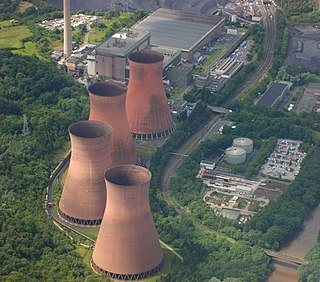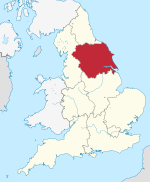
The Ironbridge power stations refers to a series of two power stations that occupied a site on the banks of the River Severn at Buildwas in Shropshire, England. The Ironbridge B Power Station was operated by E.ON UK but the site is now owned by Haworth Group. The station stands near the Ironbridge Gorge World Heritage Site. Originally powered by coal, they were converted to use 100% biomass fuel. Ironbridge B Power Station stopped generating electricity on 20 November 2015, with the decommissioning process continuing into 2017. The main phase of the 27-month demolition process began at 11:00 GMT on 6 December 2019, commencing with the four cooling towers.

The Ferrybridge power stations were a series of three coal-fired power stations on the River Aire near Ferrybridge in West Yorkshire, England, in operation from 1927 to 2016 on a site next to the junction of the M62 and A1(M) motorways.

West Ham Power Station was a coal-fired power station on Bow Creek at Canning Town, in east London. It was often referred to informally as Canning Town Power Station.

Staythorpe C Power Station is a 1,735 MWe gas-fired power station at Staythorpe between Southwell and Newark-on-Trent in Nottinghamshire, England, between the River Trent and Nottingham to Lincoln railway line. The station was handed over to the owner RWE from Alstom Power with full commercial operation being achieved in December 2010. The official opening ceremony attended by Charles Hendry, Minister of State took place on 9 May 2011.
Rotherham power station was a coal-fired power station sited close to the centre of Rotherham in South Yorkshire.
Barton Power Station was a coal-fired power station on the Bridgewater Canal in Trafford Park, near Eccles, Lancashire, England.

Hams Hall Power Station refers to a series of three, now demolished coal-fired power stations, situated in Warwickshire in the West Midlands of England, 9 miles (14 km) northwest of Birmingham city centre.

Chadderton Power Station refers to a series of two coal-fired power stations, which were situated at Chadderton, Greater Manchester in North West England.
Stuart Street Power Station was a coal-fired power station in Bradford, Manchester, England.

Darlington power station refers to a series of two coal-fired power stations situated in Darlington in County Durham, North East England.
Meaford Power Station was a coal-fired power station situated on the River Trent at Meaford near Stone in Staffordshire.
Bold Power Station refers to a series of two coal-fired power stations in Bold near St Helens, Merseyside, North West England. They were closed, decommissioned and demolished between 1981 and 1992, and a housing estate now occupies the site.

Kirkstall Power Station was a coal-fired unit opened in 1930, serving the city of Leeds, West Yorkshire, England.
Watford Power Station was a coal-fired power station situated in Watford's Riverside area. The station was built by the Watford Corporation Electricity Department starting with the installation of cables in 1899 with completion around 1900, near the banks of the River Colne. A gas turbine power station was commissioned in 1980.
Bradford Power Station was an electricity generating site located on Valley Road in Bradford, West Yorkshire, England. The primary source of fuel was coal which was railed into the sidings adjacent to the Bradford Forster Square to Shipley railway line. The plant operated for 79 years and had cooling towers constructed from wood and was noted for its 300-foot (91 m) chimney that was supposed to vent smoke away from the valley floor in Bradford Dale that the power station was located on.
Ashford Power Station refers to any of three, engine-driven, electricity generating stations located in Ashford, Kent. Two of the stations, A and B, have been demolished, and one is an operational 21 MW peaking plant.

Huncoat Power Station was located in Huncoat near Accrington, Lancashire. It was a 150 MW, coal-fired, electricity generating station in operation from 1952 to 1984. It has since been demolished. Huncoat power station replaced the earlier Accrington power station that had supplied electricity to the town since 1900.
Blackburn power stations are a series of electricity generating stations that have provided electric power to the town of Blackburn and the wider area from 1895 to the present. The first station in Jubilee Street, Blackburn began operating in 1895. A new larger station known as Blackburn East or Whitebirk power station was commissioned in 1921 and was rebuilt in stages over the period 1942 to 1955. Whitebirk station closed in 1976. The 60 MW Blackburn Mill Combined Cycle Gas Turbine (CCGT) power station has generated electricity since 2002. The Blackburn energy from waste (EfW) plant is currently (2020) being planned.
Bromborough power stations are three electricity generating stations that supplied power to industrial and domestic users in Bromborough, Port Sunlight and the wider Wirral area from 1918 until 1998. Bromborough power station provided public electricity supplies from 1951 to 1980. Central power station Bromborough (1918–1998) was originally owned by Lever Brothers and supplied electricity to domestic users in Port Sunlight as well as electricity and steam to industrial users. Merseyside power station Bromborough (1958–1998) was also owned by Unilever and provided electricity and steam at a range of pressures to industrial users in the locality. All three power stations at Bromborough have been demolished.
The Thornhill power station generated and supplied electricity to the town of Dewsbury and the wider regional area from 1902 to 1982, and again from 1998. The first generating station on the site was owned and operated by the Yorkshire Electric Power Company. Following nationalisation of the British electricity supply industry in 1948 Thornhill power station was operated by a succession of state owned bodies. The power station was redeveloped with new plant in 1915, 1925, 1932–37 and 1950–54. The coal-fired steam station was decommissioned in 1982, and was subsequently demolished. A gas turbine power station on the site was commissioned in 1998.











